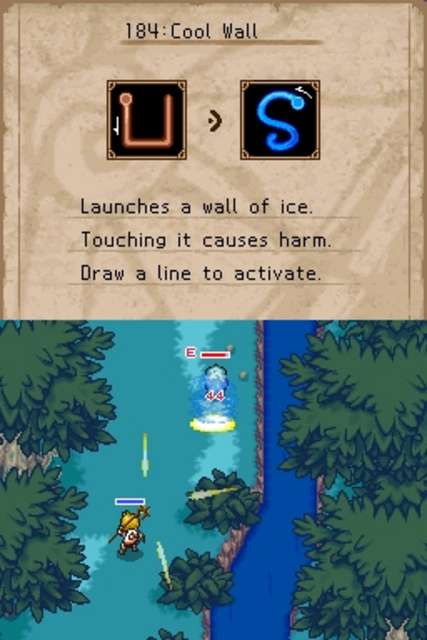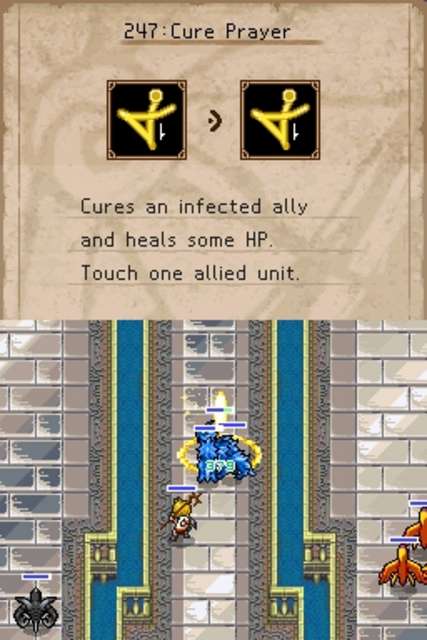Lost Magic
Found review.
Guitar Hero has a spangly guitar, Dancing Stage a blinking dancefloor and Gran Turismo a steering wheel that, when you push it, pushes you back. Samba De Amigo has tequila-fragranced maracas [sniff... Lies! - Ed], Maestromusic an erect conductor's baton and Steel Battalion a huge cock-off robot dashboard. These are all videogames that have seen their manufacturers carefully pipe plastic into (mostly) recognisable real world shapes: an effort to normalise that most alienating abstract interface - the videogame controller.
The DS's stylus is already a real-world interface. Anyone that has held a pen or chalked a board or drawn pictures in the sand with their finger already understands how it works. And so, the leap of imagination Lost Magic requires you to make - that your stylus is a magic wand with which arcane symbols must be traced to unleash magnificent physics-bending spells - is pleasingly unnoticeable. Indeed, it's such an obvious move, and one sure to be replicated on the wand-like Wii controller in one form or another, that you wonder why so many Potter tie-ins have failed to make use of it.
At least, that's what you wonder while tearing the wrapping off the box. In-game it becomes increasingly clear that this is a tricky gimmick to make good.
We've seen some of the theory outworked in Castlevania's DS title, Dawn of Sorrow. Here players are required to draw magical symbols in order to trigger whichever finishing move is required to end a boss fight. Lost Magic takes that tiny, faintly irritating gameplay element and attempts to spin a whole game out of it. You take control of Isaac, a young orphan boy wizard apprentice, as he searches for his dead father - the Bishop of the White Night (aka Russell) - and tries to evade the clutches of the equally ridiculously named Diva of Twilight.

Conversations and plot interactions all take place via text boxes and character portraits as you move from set location to set location on the overworld map a la Fire Emblem. There are no towns to explore or X-on-everything fields to traverse. The plot is silly and childish with stupid characters and awkwardly translated characterisation and dialogue; it's perfectly clear that this sphere of the game plays a lazy second fiddle to the star of the show: magic battling.
Combat is a straightforward mash-up of Real-Time Strategy cloaked in RPG menus. The stylus is used to select Isaac or one of his captured support monsters and, by clicking on any location in the battlefield, you send them toddling off from A to B. Unfortunately the AI has been viciously lobotomised with a rusty teaspoon so your characters won't path find their way around even the most inconsequential of objects meaning you'll actually be tapping out A to C to D to E to F to G to B to get across even the simplest of maps.
Holding down the L trigger pulls up a tablet onto which you can trace one of a catalogue of symbols that will trigger the corresponding spell. While on this screen the action continues to outplay around you lending a certain level of urgency to your fingered incantation. Should you mis-draw the spell symbol your spell will fail and you'll have to start again losing valuable seconds on the battlefield. Brilliantly, the more accurately you draw your spell the more damage it deals so the emphasis is on efficiency and accuracy with your drawing. There are six categories of magic in the game, which can, as usual, be divided up into three pairs that are particularly effective against each other. Using the correct type of spells on the correct type of enemy (e.g. ice against fire, etc, yawn) is paramount to success.
This all sounds great but hereafter the problems tumble over themselves for attention. There are no physical attacks available to Isaac and so, should your Magic Point gauge run dry, as it inevitably will quickly, you'll have to run around for a while to refill it. If this happens in the middle of a direct skirmish between your team and some enemies you are completely defenceless - especially as enemies are really bloody fast, so there's no point in retreating, as they'll just follow right behind you hacking away at your exposed back. As a result the game quickly becomes less about actual skill or strategy or even responding to real time situations and more a drawn out, boring war of attrition. Fire off offensive and healing spells, wait for MP gauge to refill and repeat. If your team is stronger and more appropriately allied to whichever element is most efficient for those enemies then you'll probably win; if not you probably won't: stat wars.

Pleasingly you can capture severely weakened monsters with a trap spell and incorporate them into your team (the number that you're allowed to take into battle increasing with your level). This lends the game a Pokemon dynamic - as you'll want to capture each new type of monster you encounter and turn them against their allies in the next fight. As an afterthought you can equip an item across your whole set of team mates to increase certain stats or lend status benefits. New items are littered in chests on the battlefields and so you can divide up your team mid fight and send weak units off to collect items if you so wish.
Through this option to select certain units you can theoretically send squadrons off for more complex flanking manoeuvres. However, as your units start off grouped together (at least until late in the game) and it's only possible to select groups by drawing a circle (you can't just tap the different ones you want into a group) enemies are often upon you by the time you've divided your team into formation. Irritatingly you can't order your allies' AI to behave in any other way than offensive. If an enemy wanders into their range your entire team will charge off after them with gay abandon while you helplessly wring your hands and flip to the healing page in your spell handbook.
Spellcasting becomes more and more complex as the game develops. The basic first 18 spells (each with it's own drawing pattern) can later be combined with one another to create new more powerful mixes. As a result almost 400 spells are available to the dedicated player - far too many and far too incrementally different from one another to meaningfully choose between in the heat of a battle. That said there's an excellent level of creativity with these higher-level spell combinations, which variously facilitate dragons to be summoned, and meteorite showers to be invoked.
Lost Magic as a product is furiously frustrating. The game pitch works wonderfully in the realm of theory but in practice its problems undermine most of the flashes of brilliance. Like a collection of absolutely amazing ideas all thrown together in a random and inelegant way. It seems that Taito, in calculating the sum of its game's parts got the workings all wrong.

